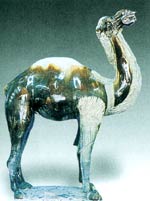A
piece of three-colored one-humped camel of the Tang Dynasty is
treasured up in the Xianyang Museum(as the picture). In 1973,it
was come out of the Qibiming’s tomb located in a place about 400
meters of the northern part of the Yaowangdong Village, Weicheng
District ,Xianyang. Now,the camel,however, is still in fair preservation
and bright color. Qibiming is the son of a famous minority leader,
Qibiheli . As reported in Wei Shu, Qibi was one of the
most widely used in the six surnames of Gaoche which were famous
tribes living in the area of the western part of Yiwu and the
mountain, Ajietian, the northern part of Nianshi .
This kind of camel has strong posture and topping hump
,with the total height of 82 centimeters .It is glazed with some
colors, such as reddish brown, yellow and milk white. It is just
like neighing with its chin up and open mouth.. Among those tri-colored
pottery in the tombs of the Tang Dynasty, most of them are the
two-humped camels, while the one-humped camel is seldom seen but
in a good condition. The largest one is the masterpiece and moreover
it is the only one in the whole nation ,deserving to be called
rarity.
The one-humped camels mainly live in the area of India,
Arabia and North Africa, but never seen in China inland. The fact
that the three-colored humped camel coming out from Qibi family’s
tombs illustrates it is the product of the trade between China
and foreign countries in the Tang Dynasty.
The passageway on land has developed the famous Silk Road
since the period of Zhangqian, serving as an envoy abroad to the
west, from Chang’an to Middle Asia, West Asia and the western
part of Arabia. During the period of Sixteen States, the Silk
Road has experienced depression for some times. It doesn’t takes
on a look of an exceptionally grand
occasion until the Tang Dynasty.
The camel is the main transport on the Silk Road. The
goods, such as jewellery, woven blanket, perfume, grape, alfalfa,
pomegranate, broad bean, walnut etc. are introduced into the Tang
Dynasty on the back of the camel through the sand beach and gobi.
All kinds of national musical instruments are brought into inland,
such as pipa, harp, five strings, flute and many dances, such
as Huxuan, Huteng and Tuozhi so on and so forth. At the same time
, the inland also absorbs many cultures, such as Buddhism, Islamism
and other cultures which are mixed together with the Hanzu’s.
As a result, the civilization of the ancient China takes on a
look of vitality unprecedentedly.
The prosperous economy and solid national power make the
Tang Dynasty enjoy a higher reputation both at home and abroad.
The envoys, traders, nobles, scholars, artists and monks of many
countries in the area of West Asia and North Africa often visit
it and trade in some goods with it. More than 70 countries have
a diplomatic relationship with the Tang Dynasty. In the court,
there is a place, called Honglu Temple, used for entertaining
guests from each nation. The accommodations are used for foreign
guests while the foreign trade is in charge of the supervisor
and the ship owner. Many foreign ambassadors have been to the
Tang Dynasty in universities and many positions are ready for
the non-Han nationality. The Arab and Persian have been managing
some hotels, jewellery stores, drugstores and wineshops etc.
Meanwhile, the great invention made by China, such as
compass, gunpowder, papermaking, printing, silk, ware, tea, and
alarm clock are also spreaded into the west on the back of the
camel. During the period from the 12th century to the
13th century, the Arab introduced them into Europe
and they were used for science and technology, culture, aviation,
military affairs and social life . As a result, after the Renaissance,
the west has produced a wide effect as long as the time of several
centuries.
The copper mirror, the copper cash, the textiles and the
three-colored wares of the Tang Dynasty
found by Samaer in the Middle Asia, the large quantities
of Chinese wares coming out from the ruins of Samala in the western
bank of Digelis River, Iraq and the celadon wares of the Tang
Dynasty coming out of Foster City(the ancient Cairo), North Africa,
which provide the archaeological proof that the Tang Dynasty carries
out foreign economy and cultural communication on the Silk Road
. This reflects a grand occasion that Chinese commodity has been
exported to the remote boundary. (Photography: Liu Xiaodong)
Editor:
Xiaoran
